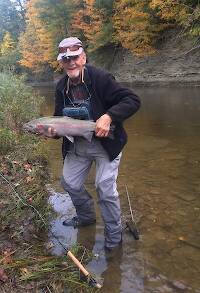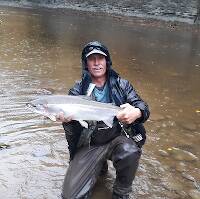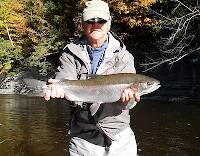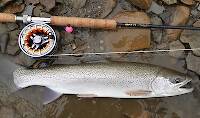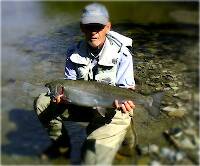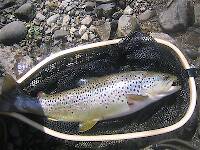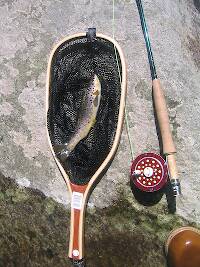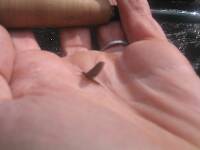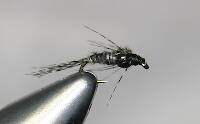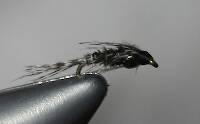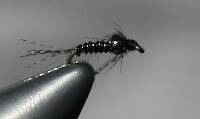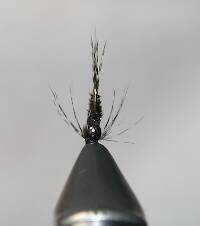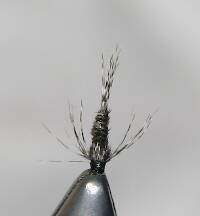
Hex Mayflies
Hexagenia limbata
The famous nocturnal Hex hatch of the Midwest (and a few other lucky locations) stirs to the surface mythically large brown trout that only touch streamers for the rest of the year.
Featured on the forum

I was not fishing, but happened to be at an unrelated social event on a hill above this tiny creek (which I never even saw) when this stonefly flew by me. I assume it came from there. Some key characteristics are tricky to follow, but process of elimination ultimately led me to Sweltsa borealis. It is reassuringly similar to this specimen posted by Bob Newell years ago. It is also so strikingly similar to this nymph from the same river system that I'm comfortable identifying that nymph from this adult. I was especially pleased with the closeup photo of four mites parasitizing this one.

Troutnut is a project started in 2003 by salmonid ecologist Jason "Troutnut" Neuswanger to help anglers and
fly tyers unabashedly embrace the entomological side of the sport. Learn more about Troutnut or
support the project for an enhanced experience here.
Martinlf on Jan 2, 2007January 2nd, 2007, 9:30 am EST
Does anyone know how useful this reference is for PA streams?
"He spread them a yard and a half. 'And every one that got away is this big.'"
--Fred Chappell
--Fred Chappell
Martinlf on Jan 3, 2007January 3rd, 2007, 11:44 am EST
Roger, thank you. I will take a look.
"He spread them a yard and a half. 'And every one that got away is this big.'"
--Fred Chappell
--Fred Chappell
GONZO on Jan 7, 2007January 7th, 2007, 8:14 am EST
Louis,
The Ames book that Roger mentions is a very good one, in my opinion. The taxonomy was up-to-date as of its publication (2000), and it is one of the few angling entomologies where I have found no misidentification of photographed specimens. (Though the fact that the photos represent sections that are variously identified to species, genus, or just family levels somewhat simplified the author's task.)
It includes a number of excellent photographs of caddisfly pupae, which alone make a fairly unique contribution when compared to many earlier texts. And nearly all of the important Eastern trout stream insects are covered. Despite the fact that Ames begins by describing what he feels are significant differences between New England streams and the PA or Catskill streams that featured prominently in many earlier works, virtually all of the species mentioned are also common to PA (and most Eastern or even Midwestern) streams. (Brachycentrus americanus is the only included species I can recall that I haven't encountered in PA.)
The only thing that I find disappointing is the section on the Eastern Drunella species. His description of them as primarily #18-20 flies that hatch at midday in July, bothered me quite a bit at first. I have to assume that the author's knowledge of them is limited to summer fishing on tailwaters like the Farmington, and that the much larger, earlier, and usually more important hatching of what used to be called Drunella cornuta (now one of the D. lata synonyms) is not something he has personally experienced.
Still, that is a fairly minor issue (even for those with a special affection for this hatch, like me), and I recommend the book highly.
The Ames book that Roger mentions is a very good one, in my opinion. The taxonomy was up-to-date as of its publication (2000), and it is one of the few angling entomologies where I have found no misidentification of photographed specimens. (Though the fact that the photos represent sections that are variously identified to species, genus, or just family levels somewhat simplified the author's task.)
It includes a number of excellent photographs of caddisfly pupae, which alone make a fairly unique contribution when compared to many earlier texts. And nearly all of the important Eastern trout stream insects are covered. Despite the fact that Ames begins by describing what he feels are significant differences between New England streams and the PA or Catskill streams that featured prominently in many earlier works, virtually all of the species mentioned are also common to PA (and most Eastern or even Midwestern) streams. (Brachycentrus americanus is the only included species I can recall that I haven't encountered in PA.)
The only thing that I find disappointing is the section on the Eastern Drunella species. His description of them as primarily #18-20 flies that hatch at midday in July, bothered me quite a bit at first. I have to assume that the author's knowledge of them is limited to summer fishing on tailwaters like the Farmington, and that the much larger, earlier, and usually more important hatching of what used to be called Drunella cornuta (now one of the D. lata synonyms) is not something he has personally experienced.
Still, that is a fairly minor issue (even for those with a special affection for this hatch, like me), and I recommend the book highly.
Martinlf on Jan 7, 2007January 7th, 2007, 9:10 am EST
Gonzo, Thanks for the information. I just have to learn to read everything in all areas of the site before making any replies. But this confirms my inclination to buy the book since you and Jason have led me well down the primrose path to bug geekdom. It's next on my list. Now, if you could just settle that Latin pronunciation issue. Roger and I were arm wrestling a bit with that topic, having some fun again. Take a look if you get time.
"He spread them a yard and a half. 'And every one that got away is this big.'"
--Fred Chappell
--Fred Chappell
GONZO on Jan 7, 2007January 7th, 2007, 10:11 am EST
Sorry Louis, you and Roger are on your own with regard to the "Latin" pronunciation debate. I've already confided my complete inadequacy in this regard. By the way, I recently tried the "Beet-iss" pronunciation on one of my regular fishing partners. The look he gave me in response is usually expressed by raising a middle digit! :)
LittleJ on Jan 7, 2007January 7th, 2007, 1:39 pm EST
gonzo,
I tried on beet-is shortly after reading the latin thread myself. Well long story short the "what the **** is that? " response quickly led me back to bay-tis.
Jeff
I tried on beet-is shortly after reading the latin thread myself. Well long story short the "what the **** is that? " response quickly led me back to bay-tis.
Jeff
GONZO on Jan 7, 2007January 7th, 2007, 2:36 pm EST
Jeff, I think the most practical rule is to "know your audience." Unless your fly-fishing buddies are entomologists or classics professors, the down-home "Bay-tis" is less likely to draw nasty looks. Unfortunately, my friends come from both sides of the Latin pronunciation tracks, so I'm basically screwed. (Trying to remember which to say to whom is likely to make my brain explode!) :)
Troutnut on Jan 7, 2007January 7th, 2007, 6:18 pm EST
I think the most practical rule is to "know your audience."
Good rule!
I'm kind of hesitant to be the first one to inject Latin names into the conversation with some new person on the stream. I cringe at the term "BWO" on principle, so I'm kind of stuck... I usually end up saying "(color) size (x) mayflies."
Jason Neuswanger, Ph.D.
Troutnut and salmonid ecologist
Troutnut and salmonid ecologist
Martinlf on Jan 8, 2007January 8th, 2007, 12:20 pm EST
Jeff. I couldn't get very many rises in the Redux thread, and should quit casting, but in case you didn't see the following, I'm cutting and posting it here. I respect Roger (Taxon) immensely, and only wish I had a tenth of his bug knowledge, but I respectfully disagree with his choice of a pronunciation guide. See below:
Recently surfing Jason's photos in an attempt to identify some nymphs, I stopped at the Family Heptageniidae and realized that the pronunciation of the double i had me flummoxed, so I did a bit of Googling. The result was the following website:
http://www.ai.uga.edu/mc/latinpro.pdf
This site not only tells why the ae in baetis should always be pronounced as the a in plate, but also why we pronounce the ae in Caesar with the sound of e in beet, a seeming inconsistency.
Gonzo, I'm not obsessing. On Hatches II, I swear I'm not.
Recently surfing Jason's photos in an attempt to identify some nymphs, I stopped at the Family Heptageniidae and realized that the pronunciation of the double i had me flummoxed, so I did a bit of Googling. The result was the following website:
http://www.ai.uga.edu/mc/latinpro.pdf
This site not only tells why the ae in baetis should always be pronounced as the a in plate, but also why we pronounce the ae in Caesar with the sound of e in beet, a seeming inconsistency.
Gonzo, I'm not obsessing. On Hatches II, I swear I'm not.
"He spread them a yard and a half. 'And every one that got away is this big.'"
--Fred Chappell
--Fred Chappell
Taxon on Jan 8, 2007January 8th, 2007, 12:38 pm EST
Louis-
This be respectful refusal, but don't get discouraged; just cast away.
This be respectful refusal, but don't get discouraged; just cast away.
Martinlf on Jan 8, 2007January 8th, 2007, 1:13 pm EST
I am; there have to be some stockies in here somewhere. :)
"He spread them a yard and a half. 'And every one that got away is this big.'"
--Fred Chappell
--Fred Chappell
Jlh42581 on Jan 9, 2007January 9th, 2007, 4:26 am EST
Its an excellent reference book for pa, thats why I recommended it. It was recommended to me by FlyFishersParadise and received as a gift for valentines day last year.
BTW: I live on the Bald Eagle and my Mother lives on Spring Creek ;)
BTW: I live on the Bald Eagle and my Mother lives on Spring Creek ;)
Jeremy
Martinlf on Jan 9, 2007January 9th, 2007, 12:12 pm EST
Lucky you for such a great fishing location!! Thanks for the recommendation. It appears a number of others on the forum like it also. I'm taking a look soon, and am sure to buy it.
"He spread them a yard and a half. 'And every one that got away is this big.'"
--Fred Chappell
--Fred Chappell
Quick Reply
Related Discussions
Topic
Replies
Last Reply
0
May 6, 2011
by Jtberez
by Jtberez
2
Mar 24, 2011
by CaseyP
by CaseyP
1
May 11, 2007
by Troutnut
by Troutnut





